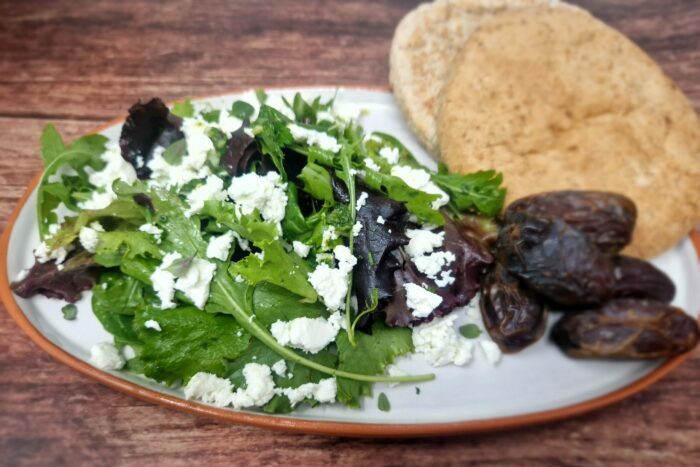Lucius Junius Moderatus Columella was a Roman soldier and farmer. He was also a prominent writer on agriculture in Roman times.
Columella’s writings show that the Roman people ate salads which were varied and interesting:
Put savory in the mortar with mint, rue, coriander, parsley, sliced leek, or, if it is not available, onion, lettuce and rocket leaves, green thyme, or catmint. Also pennyroyal and salted fresh cheese. This is all crushed together. Stir in a little peppered vinegar. Put this mixture on a plate and pour oil over it. (Columella, Re Rustica, XII-lix)
For a real Roman feel, you could serve your Columella Salad alongside pitta bread, dates or grapes, or why not try making Libum, a type of Roman bread?
Skills Check
Follow a recipe; follow food safety & hygiene rules; tidy away; use measuring jugs and spoons; cut using the bridge/claw safely; snip herbs with scissors; tear herbs; crumble ingredients.
Equipment
Chopping board, knife, blender or pestle and mortar (optional), small bowl, serving plate/bowl.
Allergens
(Please note the allergens listed are indicative only. Allergens vary depending on brand; check the labels on the products you use)
Sulphites | Milk
Ingredients (serves 4, or 8 as a side salad):
- 100g salad leaves, washed and dried
- 1/2 small leek, washed
- 15g coriander
- 15g parsley
- 1 sprig of thyme
- 1 tbsp wine vinegar
- 3 tbsp olive oil
- Pepper
- 100g feta cheese, reduced or low fat
Method
- Cut the leek in to small pieces and add to the blender, or pestle and mortar, with the coriander, parsley, oil, vinegar and pepper. Blitz (or grind/crush) to a paste. If you don’t have a blender, or pestle and mortar, finely chop the leek, parsley and coriander (or snip with scissors), and mix together with the oil, vinegar and pepper.
- Put the salad leaves on a serving plate and pour over your paste/mixture, mixing gently to ‘dress’ the salad leaves.
- Crumble the feta cheese over the dressed salad leaves.
So thinking about Columella's Salad ...

Feta cheese is a source of protein and calcium. Although lower in fat than some cheeses it should be used sparingly due to its very high salt content.
Nutritional Information
| Energy | 585kJ/141kcal | 7% | |
| Med | Fat | 12.0g | 17% |
| Med | Saturates | 3.2g | 16% |
| Low | Sugars | 0.9g | 1% |
| Med | Salt | 0.7g | 12% |
per 76g serving
% of an adult's reference intake
Typical values per 100g: Energy 772kJ / 186kcal
Notes
A traffic light system is used on nutrition labels to make it easier to see which foods and drinks are lower in calories, fat, sugar and salt. Try and choose more ‘greens’ and ‘ambers’ and fewer ‘reds’, and stick to smaller portions of ‘reds’.
Just because a recipe or a food has a red traffic light doesn’t mean you shouldn’t eat it. Understanding why a food or recipe might have a red light can be helpful. For example oily fish is high in total fat and so any recipe containing oily fish is likely to be ‘red’ for fat. But it is recommended that we eat oily fish at least once a week because the type of fat it contains is beneficial for our health.
% Reference Intakes are also shown. Reference Intakes are guidelines about the approximate amount of particular nutrients and energy required for a healthy diet (based on an average-sized woman doing an average amount of physical activity). Most children will require less than these Reference Intakes. The contribution of one serving of a food or drink to the Reference Intake for each nutrient is expressed as a percentage.




